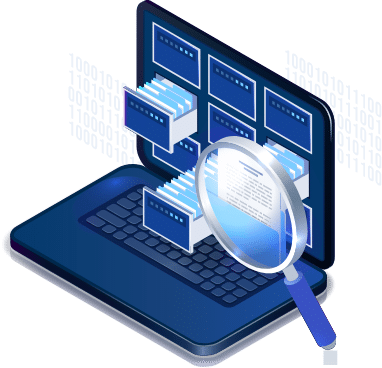Customers expect businesses to know them – completely. However, only 14% of organizations had achieved a 360-degree view of their customers by 2021, according to a Gartner survey.
The number might have increased in the past few years, considering that 80% of respondents said they aspired to reach this goal, but the reality is that a lot of companies still struggle with fragmented data, siloed systems, and inconsistent records, which make it nearly impossible for them to get a full picture of who their customers are.
A 360-degree view is the key to delivering personalized experiences, making informed decisions, and building long-term customer loyalty. But many challenges stand in the way.
What is a 360-Degree Customer View and What It Means for Your Business?
Before we discuss the challenges that make it difficult for businesses to achieve a 360-degree customer view and explore their solutions, let’s first understand what it really means and how it benefits your business.
A 360-degree customer view refers to a comprehensive, unified record that combines data from all touchpoints across your business. This includes information from sales, marketing, customer service, website interactions, social media, and any other customer data platforms or data points there may exist.
Aggregating customer data from multiple channels into one cohesive profile allows businesses to:
- Gain deeper insights into customer behaviors, preferences, and needs
- Deliver personalized experiences
- Make data-driven decisions
However, as mentioned earlier, achieving a full 360-degree view is easier said than done.
Key Challenges in Achieving a 360-Degree Customer View
Some of the most common challenges that make it difficult for businesses to achieve a 360-degree customer view include:
1. Fragmented Data Across Systems
Businesses use an average of 259 software apps and systems. Most often, these apps and systems do not communicate with each other. As a result, the data remains isolated in disparate systems, which creates silos and makes it harder for teams to find relevant data. According to research, decision-makers spend 30% of their time every week – equal to 2.4 hours daily – trying to find the right data and information.
Without integrating all your customer data from all the various sources it resides in, it is nearly impossible for business to create unified customer profiles and maintain productivity.
2. Data Inconsistencies and Duplicates
When data is gathered from diverse touchpoints, discrepancies and duplicates are bound to occur. There may be multiple profiles of the same customer across systems, and there may also be variations in names, addresses, phone numbers and emails across different datasets.
This, coupled with different formats, typos, or outdated records, can further complicate the issue and create a very messy picture of your customer records. Eventually, this lack of consistency erodes trust in the data and limits its usability.
3. Balancing Privacy and Compliance with Centralization
Businesses are held accountable for handling customer data responsibly now more than ever. The data regulations that are in place require companies to ensure they have proper consent, secure data storage, and processes in place to stay compliant.
However, balancing these obligations with the goal of centralizing customer data can get tricky.
Centralizing data often involves transferring and consolidating information across systems, which increases the risk of data breaches, potential misuse, and ultimately, of non-compliance.
4. Outdated or Inflexible Systems
Over 66% of companies still rely on mainframe or legacy applications for their core business operations. What’s more astonishing is that more than 60% of them are used for customer-facing functions. The top challenges with legacy systems include:
- Integration issues with new applications
- Limited agility
- Heightened security risks
Legacy systems often lack the flexibility or capability to handle the volume and variety of data required to build a 36-degree view.
5. Lack of Internal Alignment
Collaboration across teams or departments is a major challenge many organizations face today. The reason being teams operating independently (in silos) – with their own tools, goals, and priorities. Without alignment and shared goals, the data remains fragmented, and business initiatives fails to gain momentum.
Benefits of Achieving a 360-Degree Customer View
Despite the challenges, achieving a unified customer view is worth it. It offers a strategic advantage that can transform the way businesses operate and interact with their customers. Here’s how it pays off:
1. Enhanced Personalization
When you truly understand your customers, you can deliver experiences tailored to their preferences and needs. Whether it’s personalized product recommendations, targeted marketing campaigns, or proactive customer service, a complete view of customer enables businesses to enhance customer interactions and engage with them in ways that feel relevant and meaningful.
2. Improved Decision-Making
A unified customer view brings all your data into one place, which makes it easier to analyze and extract insights. Businesses can identify trends, predict behaviors, and make informed decisions backed by accurate and complete data.
3. Better Customer Retention and Loyalty
When customers feel understood and valued, they’re more likely to stick around. A 360-degree view helps businesses build trust and strengthen customer relationships. It helps improve customer satisfaction and fosters loyalty that can drive long-term growth.
4. Increased Operational Efficiency
Breaking down silos and consolidating data helps businesses streamline their operations. Teams can collaborate more effectively, reduce redundancies, and focus on delivering value rather than struggling with fragmented or inconsistent data.
5. Competitive Edge
Understanding your customers better than your competitors can be a game-changer. A 360-degree view gives you the insights needed to stay ahead and anticipate customer needs, such as purchase history and transactional data.
This customer intelligence helps improve your customer service interactions and differentiate your business from the rest.
Solutions to Overcome the Challenges Businesses Face in Achieving a 360-Degree Customer View
Achieving a 360-degree customer view can be daunting. But it’s not impossible. By addressing their challenges head-on with the right strategies and tools, businesses can unlock the full potential of their customer data. Here are some practical solutions:
1. Break Down Data Silos
Integrating data from various systems is the first step toward unification. Invest in tools or platforms that enable seamless data integration to allow information to flow across departments and systems. This ensures every team has access to the same, up-to-date customer information.
2. Implement Robust Data Cleaning Process
Data inconsistencies and duplicates can be addressed through regular data cleaning. Use software that specializes in data deduplication and standardization to ensure your records are accurate, consistent, and reliable. Remember, clean data is the foundation of a meaningful 360-degree view.
3. Prioritize Data Governance and Compliance
Implement strong data governance policies to build trust and meet regulatory requirements. Make sure your data collection, storage, and processing practices are transparent and aligned with regulations like GDPR and CCPA. Assigning data stewards or establishing cross-functional governance teams can help maintain compliance while centralizing data.
4. Upgrade Legacy Systems
Modern problems require modern solutions. If outdated technology is holding you back, consider upgrading to systems that are flexible, scalable, and built for integration. Many data management tools offer advanced features that can help streamline the data integration process.
5. Facilitate Cross-Departmental Collaboration
Achieving a 360-degree customer view isn’t just about technology, it also requires alignment across teams. Encourage collaboration between sales, marketing, customer support, and IT. Create shared goals and workflows that emphasize the value of a unified customer view to ensure that everyone is working toward the same outcome.
6. Leverage Specialized Data Matching Software
One of the most effective ways to overcome the issues posed by fragmented or inconsistent data is by using software designed for data matching and consolidation. Tools like DataMatch Enterprise (DME) can help unify datasets, eliminate duplicates, and standardize customer data to pave the way for a true 360-degree view or a golden record.
The Role of DataMatch Enterprise in Achieving a 360-Degree Customer View
Along with smart strategies, achieving a 360-degree customer view demands the right tools to unify, clean, and standardize data. This is where DataMatch Enterprise stands out. It helps:
1. Unify Data Across Systems
As discussed earlier, fragmented data is one of the biggest hurdles businesses face when building a 360 –degree customer view. DME bridges this gap by seamlessly integrating data from multiple sources. It creates a central repository of customer records, which then eliminates silos and enables teams to work with a single, unified source of truth. DME helps you ensure that information flows freely across the various systems within your organization.
2. Streamline Data Cleaning Processes
Manual data cleaning can be time-consuming and prone to errors. DataMatch Enterprise automates the entire process, allowing businesses to clean their data quickly and efficiently. This not only saves time but also ensures high-quality data that can be trusted for decision-making and personalized engagement.
3. Support Compliance and Data Governance
DME supports compliance efforts by providing tools for secure data management, audit trails, and accurate record-keeping. It ensures that businesses can centralize data while adhering to industry standards and regulations.
4. Empower Teams with Accurate Insights
By delivering a unified, accurate view of customer data, DME equips teams across sales, marketing, and customer service with the insights they need to make better decisions. From crafting personalized marketing campaigns to delivering exceptional customer support, the software enables businesses to operate with confidence and precision.
Conclusion: Moving Toward a Unified Customer Insights
Understanding your customers is a necessity in today’s hyper-competitive business environment. A 360-degree customer view empowers businesses to perform better customer relationship management –deliver a more personalized customer experience, build loyalty – and also make smarter decisions. However, as discussed throughout the blog post, the journey toward achieving it is not without its challenges.
Fragmented data, siloed systems, and inconsistent records can hold businesses back. However, these obstacles can be overcome with the right strategies and tools. By prioritizing data integration, cleaning, and governance—and leveraging solutions like DataMatch Enterprise—businesses can build a foundation of accurate and unified customer insights.
The payoff of this investment will bebetter customer experiences, streamlined operations, and a competitive edge in an increasingly data-driven world.
Curious how a 360-deree customer view can benefit your business? Reach out to our team for a personalized consultation or download a free trial of DataMatch Enterprise to have a firsthand experience generating a unified view.










































